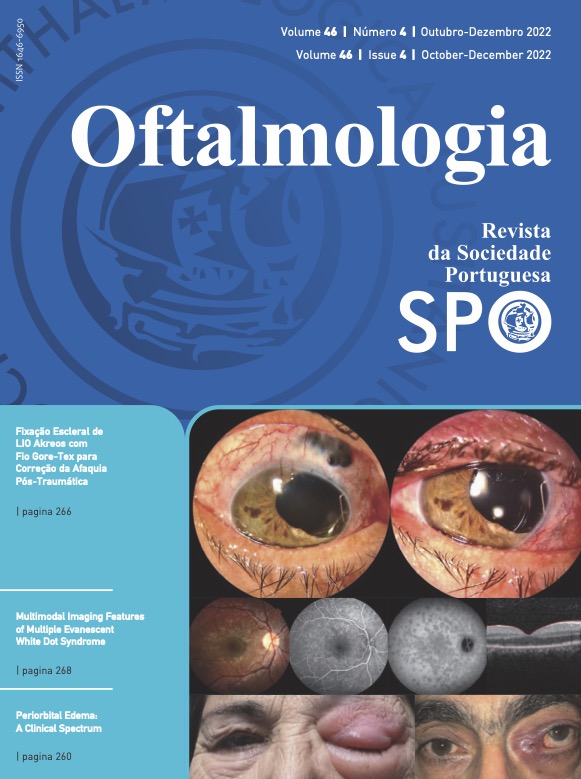Periorbital Edema: A Clinical Spectrum
DOI:
https://doi.org/10.48560/rspo.27143Keywords:
Periorbital Edema, Orbital Diseases, Orbital Cellulitis, Eyelid, Differential DiagnosisAbstract
INTRODUCTION : When the ophthalmologist evaluates a patient in the emergency department with a periorbital edema, the first approach should be directed to the distinction between a periorbital/preseptal and an orbital/postseptal cellulitis. The objective examination presents valuable sign that can help in this differentiation. The main causes of cellulitis are bacterial infections, but noninfectious causes can also lead to it. The main purpose of this work is to present 4 clinical cases of patients with the same clinical complaint but whose diagnosis, treatment and follow-up were substantially different.
CASE REPORTS: Two of the clinical cases presented patients diagnosed with a preseptal cellulitis, the first caused by an odontogenic abscess and the other caused by a Kerion celsi (a fungal infection). The last two cases presented patients diagnosed with a postseptal cellulitis caused by a frontoethmoidal mucopyocele and a squamous cell carcinoma of the maxillary sinus. The four patients had different clinical presentation and the medical and/or surgical approach varied among them.
DISCUSSION: Clinical presentation of a preseptal and a postseptal cellulitis varies and these series of cases demonstrate these semiological differences. With them, we demonstrate the variability of diseases that may be associated and present with a periorbital edema. We also enhance the importance of a correct etiologic diagnosis to a correct therapeutic approach and of a multidisciplinary approach of these patients. It is crucial for the ophthalmologist to be aware of all signs and symptoms that the patient presents with, through a complete clinical history and a detailed objective evaluation, allowing the identification of the potentially severe cases, in which an orbital invasion might exist, leading to a correct orientation and proper treatment.
Downloads
References
Sobel RK, Carter KD, Allen RC. Periorbital edema: a puzzle no more? Curr Opin Opthalmol. 2012; 23: 405-14. doi: 10.1097/ ICU.0b013e3283560ace.
Putterman AM, Liu CY. The orbital septum in upper eyelid retraction and ptosis complicating fat injection. Aesthet Surg J. 2017; 37: 62-3. doi: 10.1093/asj/sjx037.
Korn BS, Burkat CN, Carter KD. Basic and Clinical Science Course 2020-2021 - 7. Oculofacial Plastic and Orbital Surgery: Chapter 4 - Orbital Inflammatory and Infectious Disorders. Chicago: American Academy of Ophthalmology; 2021.
Bae C, Bourget D. Periorbital Cellulitis. Treasure Island: Stat-Pearls Publishing; 2022 Jan. [Cited 5 March 2022] Available from: https://www.ncbi.nlm.nih.gov/books/NBK470408/
Wong SJ, Levi J. Management of pediatric orbital cellulitis: A systematic review. Int J Pediatr Otorhinolaryngol. 2018; 110:123-9. doi: 10.1016/j.ijporl.2018.05.006.
Rafailidis PI, Falagas ME. Fever and periorbital edema: a review. Surv Ophthalmol. 2007;52:422-33. doi: 10.1016/j.survophthal.2007.04.006.
Tsirouki T, Dastiridou AI, Ibánez Flores N, Cerpa JC, Moschos MM, Brazitikos P, et al. Orbital cellulitis. Surv Ophthalmol. 2018;63:534-53. doi: 10.1016/j.survophthal.2017.12.001.
Gappy C, Archer SM, Barza M. Preseptal Cellulitis. In: Up- ToDate [Cited 5 March 2022]. Available from: https://www. uptodate.com/contents/preseptal cellulitis#H83431329
Peixoto AB, Novis CF, Vilela GM, Lerer C. Kerion: a importân- cia da sua diferenciação com infecção bacteriana do couro cabeludo. Relato de caso. Rev Bras Clin Med. 2012; 10:243-5. doi: 10.25060/residpediatr-2019.v9n1-10
Santos M, Servato J, Cardoso S, de Faria PR, Eisenberg AL, Dias FL, et al. Squamous cell carcinoma at maxillary sinus: clinicopathologic data in a single Brazilian institution with review of literature. Int J Clin Exp Pathol. 2014; 7: 8823–32.
Downloads
Published
How to Cite
Issue
Section
License
Copyright (c) 2022 Revista Sociedade Portuguesa de Oftalmologia

This work is licensed under a Creative Commons Attribution-NonCommercial 4.0 International License.
Do not forget to download the Authorship responsibility statement/Authorization for Publication and Conflict of Interest.
The article can only be submitted with these two documents.
To obtain the Authorship responsibility statement/Authorization for Publication file, click here.
To obtain the Conflict of Interest file (ICMJE template), click here





